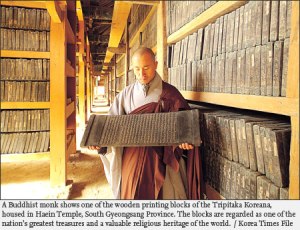Many of the bucket lists of beautiful libraries seem to focus on Western heritage libraries. But books can take many forms, especially early books, which dramatically influences the way they are preserved, displayed and studied. If we define a book as anything that can be written on, then books can take the form of clay tablets, scrolls, leaves, stones, silk or papyrus. Each of these must be kept safely; yet be accessible for scholars to study.
 The Tripitaka Koreana in storage at Haeinsa. Image Courtesy of Lauren Heckler
The Tripitaka Koreana in storage at Haeinsa. Image Courtesy of Lauren Heckler
The Tripitaka Koreana, a priceless collection of Buddhist scripture, is currently housed at Haeinsa Temple in South Gyeongsang Province. These timber printing blocks, a complete set of the Buddhist scriptures, make up one of the oldest intact libraries of the world.
 Image Courtesy of san-shin.net
Image Courtesy of san-shin.net
Surrounded by the towering Mt. Gaya, the temple has served as the home of the Tripitaka Koreana since 1251. Its Janggyeong Panjeon was specifically built in the 15th century to store the woodblocks, given the beneficial effect of its natural surroundings in helping preserve them. It faces southwest to avoid the damp southeasterly winds from the valley below, while the cold north wind is blocked by the mountain peaks. Meanwhile, differently sized windows on the northern and southern sides provide adequate ventilation.

Tripitaka is a Sanskrit word meaning Three Baskets. It is the traditional term used by Buddhists to describe their canons of scriptures. The expression “Three Baskets” originally referred to three receptacles containing the palm-leaf manuscripts on which the Buddhist scriptures were first preserved. Hence, the Tripiṭaka traditionally contains three “baskets” of teachings: a Sūtra Piṭaka, a Vinaya Piṭaka and an Abhidharma Piṭaka.
Not only is the work invaluable, it is also aesthetically treasured and shows a high quality of workmanship. Each wood block measures 70 centimeters in width and 24 centimeters in length. The thickness of the blocks range from 2.6 to 4 centimeters and each weighs about three to four kilograms.
The collection was carved onto 81,258 wooden printing blocks in the 13th century, as a means of seeking divine intervention to ward off an invasion by the Mongols. It is the world’s most comprehensive and oldest intact version of Buddhist canon in Hanja script, with no known errors or errata in the 52,382,960 characters which are organized in over 1496 titles and 6568 volumes. It also ranks as the world’s most comprehensive and oldest preserved version of Buddhist canon written in Chinese characters. It was included in the UNESCO World Heritage List in 1995.
The quality of the wood blocks is attributed to the National Preceptor Sugi who carefully checked the Korean version for errors. Because of the accuracy of the Tripitaka Koreana, the Japanese, Chinese, and Taiwanese versions of the Tripitaka are based on this Korean version.
Each block is made of birch wood from the southern islands of Korea and was treated to prevent the decay of the wood. They were soaked in sea water for three years, then cut, then boiled in salt water. Then, the blocks were placed in the shade and exposed to the wind for three years at which point they were finally be ready to be carved. After each block was carved, it was covered in a poisonous lacquer to keep insects away and was framed with metal to prevent warping.
Every block was inscribed with 23 lines of text with 14 characters per line, Therefore, each block, counting both sides, contained a total of 644 characters.

Image Courtesy of East Asian Languages and Civilizations
Since it is the most complete and accurate extant collection of Buddhist treatises, laws, and scriptures the historical value of the Tripitaka Koreana is incalculable. The compilers of the Korean version incorporated older Northern Song Chinese, Khitan, Goryeo versions and added content written by respected Korean monks. Scholars can get an idea of the older Chinese and Khitan versions of the Tripitaka from the Korean version today.


Reblogged this on greentotsclub and commented:
沒有回台灣一陣子,最近台北南港又開發了大型的購物中心,整區有南港火車站citylink與中信商場,有著新穎的商場和大型的LED帷幕。那個LED帷幕讓我想到了幾年前到北京世貿商城的天偕,當時覺得很震撼,但是不久到拉斯維加斯也發現類似的天幕。看到台北現在也有了。理應為自己的家鄉跟得上潮流覺得雀躍,但是卻莫名地提不起勁。早上剛看到這篇文章介紹南韓一座9世紀建造的寺廟至今保有著80,000多片木刻的原始大藏經。因未保留完整,目前中國、日本與台灣使用的大藏經皆源於此。據說是高麗高宗為祈願降伏蒙古軍,雕造大藏經尋求神助,非常有意思。但也因此得以保留至今。高麗大藏經涵括北宋,契丹和高麗的大藏經版本,並有高麗高僧所添加的內容,對了解古代中國和契丹的大藏經具有很高的歷史價值。這個世界上最重要藏經之一的文化遺產是韓國人的驕傲。當我們在無法創新而一位追逐潮流時,也保留就變成了一件重要的事情。在千年後,就會為當時的歷史留下一份紀錄。不知道千年後這種LED帷幕有人會保留下來嗎?
I tried to have this translated by Google, and I’m not sure if it was correct. Thank you for stopping by,